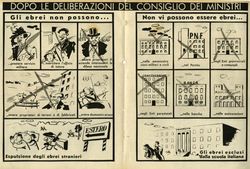Jews in Italy during Exclusion, Persecution and the Holocaust (1938-1945): Subjective Perceptions and Individual Responses
Jews in Italy were subjected to several levels of persecution between 1938 and 1945. The Fascist regime had already begun to integrate anti-Semitism into their ideological program beginning in the mid-1930s. In autumn 1938, the king, government, and Grand Council of Fascism all successively adopted discriminatory decrees, combined on 17 November into a law on the “Protection of the Italian Race”. These anti-Semitic measures affected over 58,000 people including 10,000 non-Italians. The Fascist dictatorship continued to issue additional ordinances through 1943, further marginalizing the minority in the country. Jews were no longer permitted to work in the public service or to run larger companies. They were no longer able to attend the theater or use libraries. Jewish children were forced to leave state schools. Many Jewish refugees lost their citizenship. Once the war began, the Fascists arrested both foreign and supposedly politically unreliable Jews and placed them in over 50 internment camps. The Fascists adopted these regulations in areas occupied by Italy as well. The Jewish populace became socially isolated and financially drained. Following Mussolini’s fall and subsequent peace negotiations with the Allies, the Wehrmacht invaded Italy and Italian-occupied areas in September 1943. The first arrests and massacres of Jews would immediately follow. Beginning in October, the Sicherheitspolizei and SD worked together with the Italian police to systematically carry out arrests and deportations. Nearly 8000 people were arrested, most of whom were deported to Auschwitz to be murdered.
This project investigates how those persecuted as Jews reacted to the anti-Semitic legislation. Many attempted to go into hiding using false papers, in monasteries, and in the mountains, or to flee to Switzerland or southern Italy, where the Western Allies had arrived in July 1943. While previous research has chiefly looked into types of behavior and survival strategies, this project will broaden the perspective further, perceiving the victims as individuals with a capacity for action and asks why they decided to pursue any particular option. What choices did they have and how were they affected by their social status, gender, age, and profession? What role was played by financial reserves and their relationships with non-Jews? The project will compare biographies from different Italian cities. Previously published diaries and memory accounts will be taken into consideration along with previously unpublished sources. These can be found, in particular, at the Centro di Documentazione Ebraica Contemporanea (CDEC) in Milan, at the Archivio Diaristico Nazionale in Pieve Santo Stefano, and in Jewish congregational archives throughout Italy.

